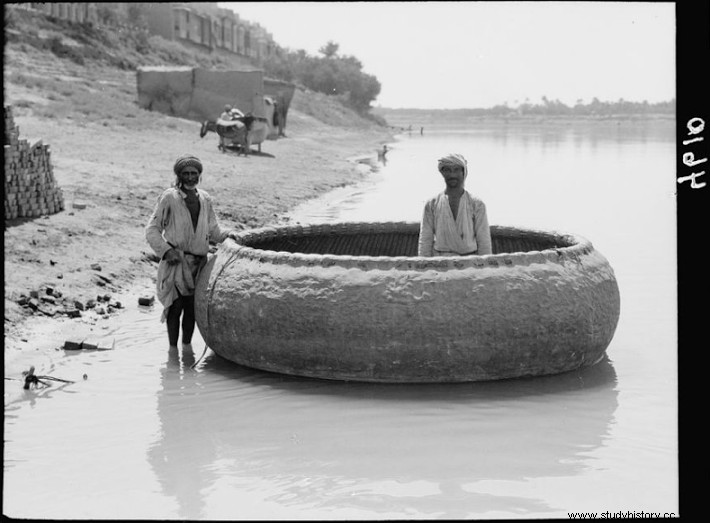Who does not know the story of Noah's Ark? It is one of the most popular legends in Western culture and every summer the ark is discovered on Mount Ararat. It has been “discovered” so many times that a fleet of ocean liners could be built with its wood. The question is, was that story real, as some ultra-religious groups maintain? Let's analyze the question.
The legend became popular thanks to the Bible. A portion of the Jewish Tanakh is based on Mesopotamian myths, which is logical, since the Jews spent time in Babylon reluctantly enjoying the gardens. The British Museum has a good number of tablets showing that they were integrated into the cultural life of the city, sending their children to city schools, and even including Babylonian religious and cultural elements in their trade stamps. But the story of the ark is older than the Bible and appears in the Epic of Gilgamesh , one of the Mesopotamian best-seller par excellence. Noah's name was Ziusudra in ancient Sumeria, Atrahasis in Assyria and Utnapishtim in Babylon. Fifteen hundred years of popularity that not even Don Quixote has managed to match. A school tablet exhibited in the Eretz Israel Museum in Tel Aviv, some 3,700 years old, found in Megiddo, shows us that the Epic was a very notorious story in that part of the world.

However, is there evidence that this legend has any truth, apart from the "numerous" arks found in Turkey? In 1929, the British archaeologist Sir Leonard Woolley he was in his sixth season of excavations in the ruins of the city of Ur when he came across a thick layer of silt. He assumed that this was proof of the deluge and so notified London in a telegram. The euphoria that arose in religious circles made the news spread like wildfire and even today this story continues to be repeated. The problem is that it is an incomplete anecdote, since Sir Leonard, when excavating in other cities, did not find the layer of mud. Other archaeologists, after him, either. He ended up coming to the conclusion that there had not been a deluge, but only floods of the rivers.
Since then, the Epic has not stopped giving us surprises because, a few years ago on a tablet in the British Museum, the philologist and Assyriologist Irving Finkel he discovered a version in which the ark is described as round. Amazing? Not that much. Keep in mind that the adventures of Gilgamesh were copied over hundreds of years, and it is obvious that the scribes must have made changes over time. Thus, for example, in the oldest version preserved in the aforementioned museum, there is no mention of a deluge, but of an enormous avenue of the river. Both details are quite logical. The rivers Tigris and Euphrates they suffer, even today, from strong floods every five or six years and, interestingly, in that part of the world round boats are popular. This type of boat, known as gufas , they are very suitable for navigating in flooded terrain, such as swamps or others, and as if that were not enough, they are very difficult to capsize. Dr. Finkel had a guide built the size described on the tablet, about 360 square meters and six meters high, and it turned out that he could navigate without any problem. It could have accommodated the inhabitants of a small town and their animals.

But we continue with the initial problem. Did there be a flood, despite Sir Leonard Woolley's doubts? Science has come to our aid in recent years. Studies carried out from the taking of more than 500 soil samples in an area of 250 square kilometers, give a different image to that of the legend. The anthropologist and archaeologist Jennifer Pournelle , from the University of South Carolina, together with archaeologist Carrie Hritz , of the Pennsylvania State University, and the geologist Jennifer Smith , from Washington University in St. Louis, have ruled, after studying these silt samples, that there was not a deluge in that area, but rather seasonal river floods, some of them enormous, linked to the strong sea ebb. It should be noted that in those times, apart from the coastline being where we now see only desert, the southern Sumerian cities were built in the middle of swamps.

Some may wonder if there is some truth to the legend after all, and to answer that we must return to Dr. Finkel's guides. And it is that the same soil samples indicate that at some point the climate behaved anomalously. Around 3000 B.C. there was a temporary climate change (a volcano is believed to be the culprit) that lasted about 150 years. A great drought ensued during which the cities were almost deserted. After that period of time, the rains returned torrentially, flooding entire towns as if they were Sumerian Venices. A guide must have come in handy in that situation, and the sight of torrents of water destroying dams and inundating cities for weeks must have left a strong imprint on the Blackheads' memories.

Since the year 1929 the flood has turned into a drought and the ark has become round. How the story changes, what Little Red Riding Hood would say! In any case, the vicissitudes of Ziusudra make us see how small we are in the face of nature and, although there has never been a deluge, a certain tablet in the British Museum reminds us that it never hurts to have a good guide at hand.
Contributed by Joshua BedwyR author of In a Dark Blue World
